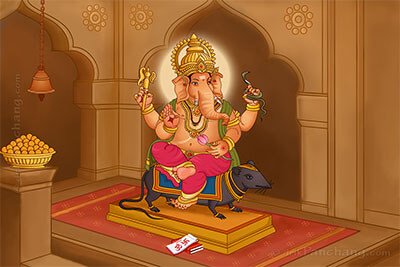





This Avatara of Lord Shri Ganesha symbolises His 'Dehi Brahma' form, and a Mouse is described as His Mount. In this incarnation, Lord Ekadanta defeated the demon Madasura. According to the story, Sage Chyavana created 'Mada.' Following his father Sage Chyavana's orders, Mada went to the Patala Loka to meet Shukracharya. He prayed to Shukracharya, saying that he was the son of Sage Chyavana, and therefore, he should be considered as a son to Shukracharya as well. Mada also expressed his desire for Shukracharya to accept him as a disciple and help him establish dominion over the universe. Shukracharya then initiated him into the one-syllable 'Hreem' Mantra and instructed him to perform penance.

Following his Guru's instructions, he immersed himself in rigorous penance. He continued his penance for thousands of years. Trees and vines grew around him, and his entire body transformed into a skeletal frame. Pleased with his intense penance, Goddess Simhavahini Bhagwati appeared before him. She granted his wishes, blessing him with eternal health, a flawless reign over the universe, and the fulfillment of all his desires. Madasura returned to his city and began ruling steadfastly. During this period, he married Salsa, the daughter of Pramadasura, and they had three sons named Vilasi, Lolupa, and Dhanpriya.
Intoxicated by the boon given by the goddess, Madasura launched attacks on Earth, Heaven and Kailasha. The rule of demons spread everywhere. Practices like Swaha, Swadha, and Vashatkara, along with all righteous duties, disappeared. Subsequently, the Gods sought a solution to this crisis from the great sage Sanatakumara. He instructed them on the Ekakshari Mantra of Lord Shri Ganesha and revealed the method to meditate on His 'Ekadanta' form as follows:
"Lord Shri Ganesha has a single tusk and four arms. His face resembles that of an elephant. He is known as Lambodara, and He is accompanied by Siddhi and Buddhi. He rides atop a mouse, and Sheshanaga resides in His navel. In His hands, He holds a noose, an axe, a lotus, and the gesture of granting fearlessness. His radiant face blooms with joy. He is a benefactor to devotees and a destroyer of the non-devotees. I meditate upon Him."
Then the Gods asked Sage Sanatakumara the meaning of the word 'Ekadanta.' Sage Sanatakumara explained it to them -
"'Eka' symbolizes Maya (illusion), which is embodied and indulgent in nature. 'Danta' represents the essence of existence, signifying the Supreme Being without any doubt. Lord Shri Ganesha, as the bearer of Maya, remains firmly rooted in the essence of existence, embodying the form of the Supreme Being. For this reason, Vedic scholars honor and refer to Him as Ekadanta, recognizing His profound connection to both Maya and ultimate reality."
"After nearly a hundred years of intense penance, Mahaganapati 'Ekadanta' appeared and asked the Gods to request a boon. The Gods prayed to Him for liberation from the terror of Madasura. Lord Shri Ganesha granted their wish by saying, 'Tathastu' (so be it). On hearing this news, Madasura became furious and set out for battle. His commanders saw the fierce, mouse-mounted, massive human-elephant form wielding weapons like the axe and noose in His four hands. The demons and Asuras panicked with fear. Then the demons asked Lord Shri Ganesha - "Who are you? Your extraordinary form has left our master astonished. What is your purpose? Please resolve our doubts."
Lord Ekadanta revealed His identity, stating - "I dwell in Svananda, and I have come from there to defeat Madasura and restore happiness to the Gods. If Madasura wishes for his own well-being, he must return the Gods' rightful privileges, relinquish his hostility toward them, and seek my refuge. Otherwise, I shall inevitably destroy him." The messenger carried this declaration to Madasura, further reminding him of Narada Ji's prophecy, and urging him to heed the warning given by Lord Ekadanta. Despite the warnings, Madasura advanced to battle, aiming to strike Lord Shri Ganesha with his bow. However, Lord Ekadanta's powerful axe swiftly pierced his chest, rendering him unconscious as he collapsed to the ground. Upon regaining consciousness, Madasura attempted to lift the divine axe but was astounded when it returned to Lord Shri Ganesha's hands. This revelation awakened him to the truth that Lord Ekadanta was the supreme Paramatma. Madasura abandoned his demonic nature, prostrated humbly before the Lord, earnestly sought forgiveness for his misdeeds, and prayed for the divine blessing of unwavering devotion and surrender.
Then Lord Ekadanta instructed the demon - "Avoid places where my worship and adoration, brimming with divine prosperity, occur. Instead, indulge in consuming the outcomes of actions steeped in demonic tendencies." Grateful for this boon, Madasura retreated to the Patala Loka. The gods, overjoyed, extolled the Mouse-mounted Lord with heartfelt reverence before departing joyfully to their celestial abodes.
Once, Lord Vishnu devotedly worshipped Lord Ekadanta, who, delighted with His dedication, granted Him the divine gem Chintamani. Lord Vishnu, in turn, presented this sacred gem to the great sage Kapila. However, Ganasura, a demon, forcefully took the gem from Sage Kapila. Enraged by this injustice, Lord Ekadanta appeared, beheaded Ganasura, and graciously restored the precious gem to the grateful Sage Kapila.